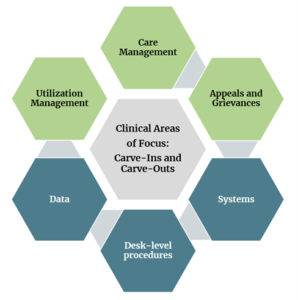Introduction to Benefit Carve-Ins and Carve-Outs:
Healthcare payers often carve out specific healthcare benefits that their members receive, such as transportation, dental, vision, and behavioral health services, to other entities who specialize in these benefits (delegated entities). Sometimes, they also bring these benefits back in-house from the delegated entity, which is often referred to as carve-ins. These carve-ins and carve-outs of benefits are typically driven by mandates from state and federal regulations, cost optimization strategies, or service quality considerations.
Planning and implementing Benefit Carve-Ins and Carve-Outs:
Planning and implementing a carve-in or carve-out is a complex undertaking that involves almost every department within a healthcare payer and numerous external entities. Therefore, planning these projects meticulously and implementing them correctly and comprehensively is vital. Failure to do so will lead to unwanted outcomes such as non-compliance, member dissatisfaction, provider aberration, and, potentially, financial losses.
Anoteros has helped several local and national payers with these types of projects both on the clinical side (Care Management, Utilization Management, Appeals and Grievances Management) and the administrative side (Member Services, Provider Services, Claims, etc.). Our approach is driven by our deep understanding of the healthcare payer space and our experience planning, implementing, and monitoring benefit carve-ins and carve-outs. This Insights article focuses on the critical clinical areas impacted by such an initiative.
Clinical areas of focus during Benefit Carve-Ins and Carve-Outs:
There are six critical areas of clinical focus when a payer decides to carve in or out benefits. The payer and the delegated entity need to discuss and agree on these critical aspects with a shared understanding of the current and post-implementation states to ensure continuity of services and a well-managed transition that does not negatively impact the member.

1.Care Management (CM):
Member needs identification:
Identifying member needs for the service is a critical component for success. For example, Anoteros recently assisted a health plan client with an initiative to carve-in behavioral health services. Member needs for behavioral health services are identified both proactively and reactively. Proactive identification methods include assessments and screenings during member onboarding, ongoing member contacts, and special events. Reactive identification methods include analyzing enrollment and risk data, monitoring service authorizations, and reviewing member claims. Existing identification methods should remain intact after the carve-in and carve-out process, and additional methods can be identified.
Care model development:
Care model development is designing proactive and reactive intervention methods for specific healthcare needs to ensure better health outcomes and regulatory compliance. Regulatory requirements and industry best practices often dictate the design of care models. While carving in and out benefits, payers and delegated entities should use the opportunity to analyze historical data and refine the existing model. It is also essential for the organization taking over management of the benefit to understand the pros and cons of the model and how members adapt to it.
Care management and Care coordination:
The care model is the basis for managing the member’s care and coordinating their services. Based on the model, clinical and non-clinical staffing requirements must be assessed and updated to support ongoing activities. In addition, members and providers must be educated well in advance on any changes based on the carve-in or carve-out.
2. Utilization Management (UM):
Provider education and coordination:
Carving in or out of services impacts the provider community significantly. Providers need to be notified about the timing of the transition. They need to be educated on how and where to submit service requests/authorizations in the future and if there are any changes to existing provider contracts. These activities must be planned and executed to consider the time needed for the provider community to adapt to the transition successfully.
UM process changes:
The impact of the staffing model within the UM department of the current organization and the organization taking over the benefits needs to be analyzed. Staffing changes should be implemented correctly, and staff should be trained appropriately. In addition, UM policies and procedures need to be either developed or updated to manage the benefit as per the new ownership. These updates should include end-to-end UM processes – intake, clinical reviews, physician reviews, provider and member communications, and regulatory reporting.
3.Appeals and Grievances (AG):
Education and coordination – Providers, Members, and Member representatives:
Providers need to be educated on how and where to submit appeals in the future and if there are any changes to existing provider contracts. Likewise, members and member representatives must be informed about the transition and educated on how and where to submit appeals and member grievances. These activities must be planned and executed to consider the time needed for the provider community to adapt to the transition successfully.
AG process changes:
The impact of the staffing model within the AG department of the current organization and the organization taking over the benefits needs to be analyzed. Staffing changes should be implemented correctly, and staff should be trained appropriately. In addition, AG policies and procedures need to be developed or updated to manage the benefit as per the new ownership. These updates should include end-to-end AG processes – intake, clinical reviews, physician reviews, committee reviews, provider and member communications, and regulatory reporting.
4.Data:
All decisions from start to finish of the carve-in/out implementation should be data-driven. The entity that currently manages the benefit should provide detailed data insights. Some examples include the percentage of the population receiving the benefit, the high-risk and high-cost population, current caseloads for care managers, and the number of member grievances. These numbers will help the new entity plan and implement the transition.
5.Systems:
All aspects of the technology ecosystem should be considered during these types of initiatives. Existing data should be migrated to the new system to ensure continuity and limit impact on members and providers. The new system should support necessary access and restrictions, facilitate workflows, and offer reporting and analytics needed for internal and external entities.
6.Desk-level Procedures:
The final and most crucial aspect is documenting desk-level procedures that bring various aspects of people, process, and technology together and make it consumable for the end users so they can efficiently perform day-to-day operations and ensure that the desired outcomes are achieved, be it service quality improvement, member and provider satisfaction, regulatory compliance, or cost savings
Contact us to start a conversation.
